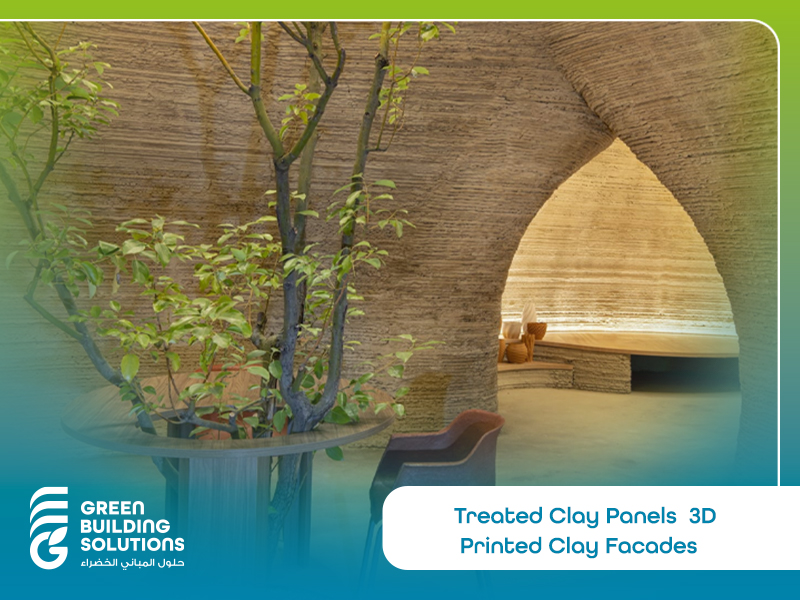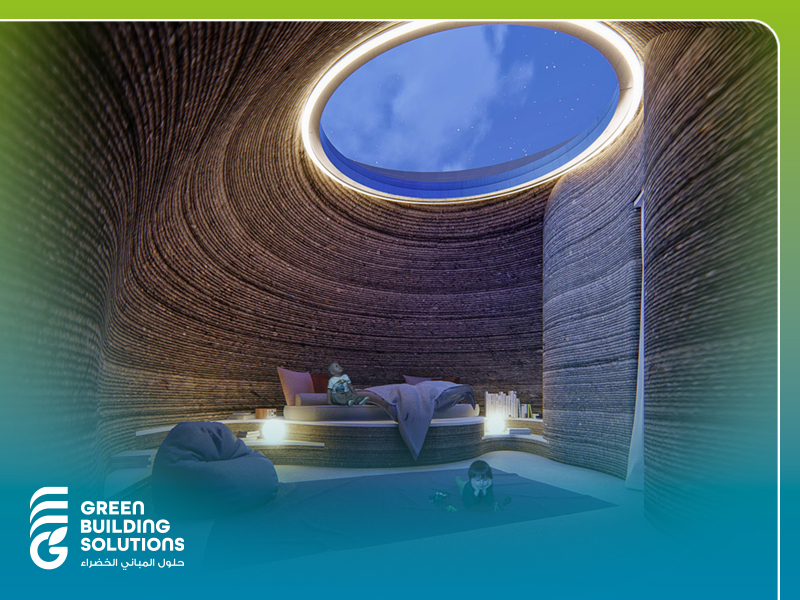Treated Clay Panels – 3D Printed Clay Facades: A New Era in Sustainable Architecture

The construction industry is constantly evolving, and with increasing demand for sustainability and innovation, 3D printed clay facades are emerging as one of the most exciting solutions in modern building products. Treated clay panels have been a key part of eco-friendly design solutions for years, but the integration of 3D printing technology is revolutionizing how these materials are used in construction. These advancements are helping architects and developers create energy-efficient projects with greater precision, flexibility, and customization.
In this article, we will explore Treated Clay 3D Printed Products, why they are a revolution in building materials, their key features, and how they are applied in facades and interior design. Additionally, we will discuss how 3D clay products contribute to cost reduction and efficiency improvement in modern construction projects.
What Are Treated Clay 3D Printed Products?

Treated clay 3D printed products refer to clay panels that have been processed and shaped using 3D printing technology to create highly detailed and customized designs. These products combine the traditional benefits of treated clay—such as sustainability, durability, and thermal insulation—with the cutting-edge technology of 3D printing to produce innovative and precise building materials.
The third generation treated clay panels offer enhanced durability and improved performance, making them suitable for both facade solutions and interior applications. Thanks to 3D printing, these panels can be created with intricate patterns, designs, and textures that were not possible with traditional methods.
Why Are They a Revolution in Building Materials?
Treated Clay 3D Printed Products are considered a revolution in building materials for several reasons:
- Customization:
One of the most significant advantages of 3D clay products is their ability to be fully customized. 3D printed clay facades allow architects to create intricate, unique designs that suit specific project needs, offering a level of creativity and personalization that was previously unattainable with traditional building materials like wood or stone. - Sustainability:
Eco-friendly clay panels for sustainable architecture are made from natural materials and are fully recyclable. When combined with 3D printing technology, these panels contribute to reducing waste during production, making them an environmentally responsible choice. Green building solutions for energy-efficient projects benefit greatly from the low environmental impact of 3D printed clay facades. - Efficiency in Production and Installation:
The ability to print treated clay products directly reduces the need for extensive labor and raw material waste. Installation services for clay panels are also more efficient because 3D printed clay facades are precise and easier to assemble than traditionally crafted materials. - Innovation:
The use of 3D printing technology allows for innovative designs, which can range from modern geometric patterns to organic, flowing forms. This technology opens up new possibilities for modern building products, offering architects a tool to create facade solutions that are both aesthetically pleasing and functional.
Learn more about: PHOMI Clay Panels: The Complete 2025 Guide to Eco‑Friendly Wall Solutions
Key Features (Customization, Flexibility, Innovation)
Treated clay 3D printed products offer a range of features that set them apart from traditional building materials:
1. Customization
3D printed clay products can be tailored to specific design needs, allowing for the creation of highly detailed and unique patterns that are difficult to achieve with other materials. From texture and shape to color and finish, every aspect of the product can be customized, making it ideal for eco-friendly interior and exterior design solutions.
2. Flexibility
The flexibility of 3D printed clay enables designers to experiment with complex shapes and structures. Flexible clay products can be used for facade cladding with various finishes and effects, providing creative freedom for architects. This flexibility extends to both facades and interior applications, ensuring that the design vision is brought to life.
3. Innovation
Treated clay products combined with 3D printing technology introduce a level of innovation previously unseen in traditional construction methods. This blend of modern technology and traditional materials offers an exciting new approach to green building solutions that prioritizes sustainability and energy efficiency.
Read the full article on: Econiclay Display Panels by Green Building Solutions
Applications in Facades and Interiors
3D printed clay facades and treated clay panels are used in both exterior and interior design applications. Here’s how they are making an impact:
1. Exterior Facades
3D printed clay panels offer highly detailed, customizable designs for facade solutions. These panels not only enhance the aesthetic appeal of buildings but also offer excellent durability and energy efficiency. Heat-resistant façade cladding solutions for hot climates are especially useful in regions like Saudi Arabia, where climate control is a significant concern. Treated clay facades can help reduce the amount of heat entering the building, decreasing the need for cooling and improving overall energy efficiency.
2. Interior Design
3D printed clay products are being used for interior applications such as walls, columns, and ceiling designs. Their ability to be customized means that architects can create unique interior features, from modern minimalism to more intricate, textured designs. The natural insulation properties of eco-friendly clay panels also contribute to the comfort of indoor spaces by maintaining a consistent temperature.
3. Sustainable Building Solutions
The use of treated clay products in both facades and interiors contributes to green building solutions for energy-efficient projects. Eco-friendly clay panels help regulate temperature, reduce energy consumption, and are fully recyclable, making them a top choice for projects aiming to achieve high sustainability ratings.
Get detailed insights on: How to Choose the Right Façade Material?
How 3D Clay Helps Reduce Cost and Improve Efficiency
3D printed clay products offer significant cost and efficiency benefits, both in terms of production and installation:
- Cost Reduction:
By using 3D printing technology, manufacturers can produce treated clay panels with minimal waste. This reduces the cost of raw materials and cuts down on labor costs associated with traditional methods of shaping and molding clay products. - Speed of Production:
3D printed clay facades can be produced much faster than traditional clay panels, as the printing process is automated and requires less time for customization. This results in faster project timelines, allowing contractors to complete installations more efficiently. - Ease of Installation:
Treated clay panels are designed for easy installation. Their precise measurements and customized fit reduce the need for adjustments on-site, improving overall construction efficiency. This leads to cost savings and ensures a smoother project flow.
Discover more about: Green Building Certifications: The Ultimate Guide to Sustainable Construction in 2025
Examples of 3D Printed Clay Projects

- Residential Buildings:
Many modern residential projects have embraced 3D printed clay facades for their innovative design and energy efficiency. These panels not only enhance the building’s appearance but also help regulate indoor temperatures, contributing to a more sustainable and comfortable living environment. - Commercial Spaces:
3D printed clay panels are being used in commercial buildings such as office towers, shopping malls, and restaurants. These materials help create visually striking and functional facades while offering green building solutions that align with sustainable practices. - Public Buildings:
Government buildings, schools, and cultural institutions are increasingly using 3D printed clay facades to create durable, eco-friendly, and energy-efficient structures. These projects often prioritize sustainability and innovation, making Iconic Clay products a perfect fit for their goals.
Find out more about: Top Green Building Solutions Provider in Saudi Arabia
FAQs about 3D Clay Products
- What makes 3D printed clay products different from traditional materials?
3D printed clay products offer customization, flexibility, and energy efficiency that traditional materials like stone and wood can’t match. They are made from eco-friendly materials and can be produced quickly and efficiently. - Are 3D printed clay facades suitable for hot climates?
Yes, 3D printed clay products offer heat-resistant façade cladding solutions, making them ideal for regions with hot climates like Saudi Arabia. - How do I buy 3D clay products?
You can purchase Iconic Clay products and 3D clay panels through professional suppliers and installation services for clay panels, wood, and stone alternatives. Prices vary depending on the customization and volume of materials required. - How do 3D printed clay panels help with energy efficiency?
The insulation properties of treated clay panels help maintain indoor temperatures, reducing the need for air conditioning and heating, which leads to lower energy consumption. - What are the 3D clay product prices?
3D clay product prices depend on size, design, and supplier, with affordable options for sustainable projects. - Which are the most innovative construction companies?
Innovative construction companies focus on sustainable materials, smart façade systems, and energy-efficient building solutions. - What installation services are available for clay panels, wood, and stone alternatives?
Installation services include professional fitting of clay panels, wood, and stone alternatives with durable and eco-friendly finishes.
Treated Clay Panels – 3D Printed Clay Facades are paving the way for a new era of sustainable, energy-efficient construction. These modern building products offer unparalleled design flexibility, cost savings, and eco-friendly advantages, making them ideal for a wide range of architectural projects.
If you’re interested in incorporating 3D printed clay panels into your next project, GBS offers installation services for clay panels, wood, and stone alternatives. Contact us today to explore how we can help you create a sustainable, innovative, and aesthetically stunning building.
